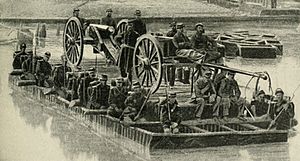Skirmish at Pace's Ferry facts for kids
Quick facts for kids Skirmish at Pace's Ferry |
|||||||
|---|---|---|---|---|---|---|---|
| Part of the American Civil War | |||||||
 Union artillery and infantry cross the Chattahoochee River in a canvas pontoon boat |
|||||||
|
|||||||
| Belligerents | |||||||
| Commanders and leaders | |||||||
| Oliver O. Howard | |||||||
The Skirmish at Pace's Ferry was a small but important battle during the American Civil War. It happened on July 5, 1864, near Pace's Ferry, which is close to Atlanta, Georgia. During this fight, soldiers from the Union Army took control of a key bridge. This bridge crossed the Chattahoochee River. Taking the bridge helped the Union army continue its plan to capture Atlanta. Atlanta was a very important city for supplies and railroads.
What Happened at Pace's Ferry?
The March to Atlanta
In the spring and summer of 1864, Union General William Tecumseh Sherman led his army closer to Atlanta. They fought many battles against the Confederate Army, led by General Joseph E. Johnston. Sherman's army kept moving around the Confederate positions. This allowed them to get closer and closer to Atlanta.
General Oliver Otis Howard's soldiers were chasing the retreating Confederates. They followed the Western and Atlantic Railroad. General Thomas J. Wood's group was at the front of this chase.
A Key Bridge Captured
The Union soldiers did not face much resistance at first. This changed when they reached Vining's Station. From there, a road led east towards Atlanta. This road crossed the Chattahoochee River at Pace's Ferry.
The Confederates had built a special bridge there. It was a pontoon bridge, which is a bridge made of floating sections. The Chattahoochee River was deep and flowed quickly.
Wood's soldiers met a group of Confederate cavalry (soldiers on horseback). These Confederates were fighting on foot. They were hiding behind barricades made of railroad ties. These barricades were on a ridge, about a quarter-mile from the train station.
Wood's men quickly pushed the Confederates away from these barricades. They then moved quickly towards the river. The Confederates tried to burn the pontoon bridge. They wanted to stop the Union army from using it.
But Wood's soldiers arrived just in time. They saved most of the bridge. The Confederates had cut the ropes on their side, so the bridge was floating freely. But it was still mostly there and could be used.
Moving Onward
General Howard saw that the Confederate positions across the Chattahoochee River were very strong. He decided not to attack them directly. Instead, he ordered his soldiers to set up camp on high ground facing the river. They waited for their own pontoon bridges to arrive.
On July 10, some of Howard's groups moved to a place near Sope Creek. They went there to help General John Schofield. Schofield had already crossed the river north of Pace's Ferry. This move helped the Union army get around the Confederate defenses.
The next day, July 11, General Howard received new orders. He was told to secure the high ground across from Powers' Ferry. This was to protect the building of another bridge there. The next morning, Howard's soldiers completed this task. They crossed the river using Schofield's bridge.

